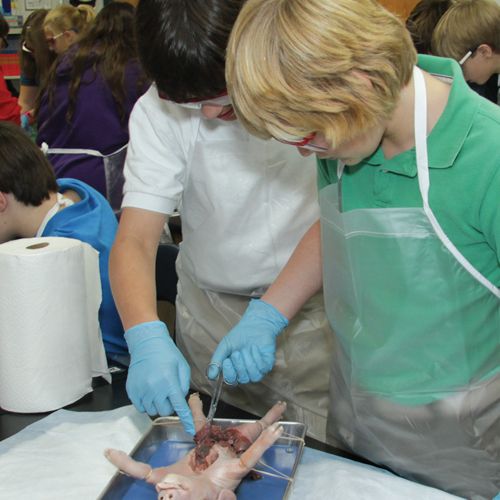My Cart
Your Shopping Cart is currently empty. Use Quick Order or Search to quickly add items to your order!

Gordon Reese
Product Manager, Preserved Materials and Prepared Slides
Comparative anatomy is an excellent approach to study the diversity of animal adaptations. Members of Kingdom Animalia have a variety of physical traits that enable them to survive in a wide range of environments, from the dark depths of the Pacific Ocean to the hot sands of the Sahara Desert. Students can examine the special adaptations that enable animals to survive in a particular environment by performing an inquiry-based dissection activity, such as the one presented in this article. This activity is appropriate for middle school and high school students. You can easily modify the procedure and the selection of species of study to meet your classroom needs.
In this activity, students study the hydra, sea star, earthworm, perch, and frog. Data tables include space to record information about the pig, mentioned in the "Extension activities" section below. Each of these species represents a member of Kingdom Animalia with various adaptations. Students first observe the external anatomy of the organisms and answer questions about their observations, then complete dissections of the organisms and compare the body systems.
Have students wear safety glasses or goggles, gloves, and lab aprons when dissecting.
External Characteristics |
Hydra |
Starfish |
Earthworm |
Perch |
Frog |
Pig |
Modifications of outer tissue |
No covering, jelly-like tissue |
Spiny, hard shell |
Segmented, smooth tissue; specialized enlarged area for reproduction without segmentation |
Scales and bony fins |
Smooth |
Body covered in short hair, whiskers |
Color/s and markings |
Colorless/white |
Dorsal side is darker than ventral side |
Dark pink/red/brown |
Yellow striped, dorsal side is darker than ventral side |
Spotted, dorsal side is darker than ventral side |
Pink |
Dentition |
None |
None |
None |
Many sharp teeth |
Small teeth in upper and lower jaws |
Teeth not well developed |
Defense |
Stinging nematocysts |
None |
None |
Spines on dorsal fin |
Mucus glands in skin |
None |
Eyes |
None |
Spines |
None |
1 on either side of head |
1 on either side of head |
1 on either side of head |
Symmetry |
Radial |
Radial |
Bilateral |
Bilateral |
Bilateral |
Bilateral |
Appendages |
None |
5 |
None |
Paired pelvic and pectoral fins, caudal fin, dorsal fins, anal fin, caudal fin |
4: 2 forelimbs and 2 longer and larger hind limbs; webbed feet |
4: 2 forelimbs and 2 larger hind limbs; hoofed feet |
Mode of locomotion |
Sessile |
Water-vascular system (tube feet) to crawl across surfaces on ocean floor |
Contraction and relaxation of setae to propel through soil |
Muscle contractions of body and movement of fins to propel and direct through water |
Use legs to jump, swim, climb, walk, and burrow |
Use legs to walk, run, dig, and climb |
Internal Anatomy |
Hydra |
Starfish |
Earthworm |
Perch |
Frog |
Pig |
Respiratory system |
Diffusion of gases |
Diffusion of gases aided by tube feet |
Diffusion of gases |
Gills, covered with operculum |
Lungs |
Lungs with alveoli, diaphragm |
Circulatory system |
Nutrients diffuse throughout body |
Network of fluid-filled canals that aid in nutrient transport; no heart |
Closed, aortic arches, dorsal and ventral blood vessels; no heart |
Closed, 2-chambered heart (atrium and ventricle), system of arteries and veins, 4 pairs aortic arches |
Closed, 3-chambered heart (2 atria, 1 ventricle), arteries and veins |
Closed, 4-chambered heart (2 atria, 2 ventricles), arteries and veins |
Digestive system |
Mouth and gastrovascular cavity |
Mouth, stomach, intestine, anus |
Mouth, pharynx, esophagus, crop, intestine, gizzard, anus |
Mouth, esophagus, stomach, pyloric caeca, pancreas, spleen, gall bladder, liver, small intestine, anus |
Mouth, esophagus, stomach, pancreas, liver, gall bladder, small intestine, large intestine, cloaca |
Mouth, esophagus, stomach, liver, gall bladder, pancreas, small intestine, large intestine, cecum, anus |
Skeletal system |
None |
None, calcified exoskeleton |
None |
Vertebrae, calcified bones and bony fins |
Vertebrae and ribs, bony skeletons |
Vertebrate, bony skeletons |
Nervous system |
Nerve net |
Nerve net, nerve ring, and radial nerve |
Ventral nerve cord |
Brain (forebrain, midbrain, hindbrain), spinal cord, nerves |
Brain with 10 pairs of cranial nerves |
Brain with 12 pairs of cranial nerves |
Carolina has many kits that will aid you and your students in a study of animal diversity through dissection. The Comparative Animal Dissection Kit examines 9 animals from different groups. In addition to the animals described in this study (with the exception of the pig), the kit includes sycon sponges, mussels, crayfish, and grasshoppers with enough materials for a class of 24 students working in pairs.
For an advanced look at animal diversity and evolutionary relationships, the Animal Diversity Set for AP* Biology contains 13 representative organisms from the animal kingdom, along with instructions to perform dissections.
The Studying Classification with Cladograms Kit provides students with practice in classifying animals according to their morphological traits and making cladograms to visualize these relationships.
*AP is a registered trademark of the College Board, which was not involved in the production of, and does not endorse, this product.